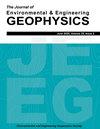Applications and Analytical Methods of Ground Penetrating Radar for Soil Characterization in a Silvopastoral System
IF 0.7
4区 工程技术
Q4 ENGINEERING, GEOLOGICAL
引用次数: 2
Abstract
The use of ground penetrating radar (GPR) for soil characterization has grown rapidly in recent years due to substantial increases in computer processing power and advances in GPR methodologies. However, few studies have focused on applied GPR analysis for soil characterization and decision making in agricultural systems. In this study, we explored applications of some common qualitative and quantitative methods for GPR analysis and characterization of subsurface conditions in a silvopasture system. We analyzed GPR results using traditional visual interpretation methods to delineate depth to bedrock, clay layers, and other important soil features. Estimates of depth to bedrock correlated well with values measured in the field ([Formula: see text]), and estimates of depth to clay layers were marginally correlated with observed values ([Formula: see text]). We also extracted attributes from GPR images to train a random forest regression model to predict coarse fragment percentage and percent clay content. GPR attributes were found to be good predictors of soil coarse fragments, with an R2 value of 0.81 and root mean square error (RMSE) of 18.82 for test data. Our results demonstrate GPR can provide valuable information on subsurface features in silvopastoral systems. These results also suggest a strong potential for machine learning algorithms in GPR data analytics. Data generated using these methods could be integrated with or used to validate existing digital soil mapping methods and contribute to better understanding of subsurface characteristics for optimized soil management in silvopastoral systems.探地雷达在森林土壤表征中的应用及分析方法
近年来,由于计算机处理能力的大幅提高和探地雷达方法的进步,使用探地雷达(GPR)进行土壤表征迅速增长。然而,很少有研究将探地雷达分析应用于农业系统的土壤表征和决策。在这项研究中,我们探索了一些常见的定性和定量方法在探地雷达分析和表征森林植被系统地下条件中的应用。我们使用传统的视觉解释方法分析了探地雷达结果,以描绘基岩、粘土层和其他重要土壤特征的深度。基岩深度估计值与现场测量值的相关性很好([公式:见文本]),而粘土层深度估计值与观测值的相关性很小([公式:见文本])。我们还从GPR图像中提取属性,训练随机森林回归模型来预测粗碎片百分比和粘土含量百分比。GPR属性对土壤粗粒碎片具有较好的预测作用,R2值为0.81,均方根误差(RMSE)为18.82。研究结果表明,探地雷达可以提供有价值的地下特征信息。这些结果也表明,机器学习算法在探地雷达数据分析方面具有很大的潜力。使用这些方法生成的数据可以与现有的数字土壤制图方法集成或用于验证,并有助于更好地了解地下特征,以优化森林系统的土壤管理。
本文章由计算机程序翻译,如有差异,请以英文原文为准。
求助全文
约1分钟内获得全文
求助全文
来源期刊

Journal of Environmental and Engineering Geophysics
地学-地球化学与地球物理
CiteScore
2.70
自引率
0.00%
发文量
13
审稿时长
6 months
期刊介绍:
The JEEG (ISSN 1083-1363) is the peer-reviewed journal of the Environmental and Engineering Geophysical Society (EEGS). JEEG welcomes manuscripts on new developments in near-surface geophysics applied to environmental, engineering, and mining issues, as well as novel near-surface geophysics case histories and descriptions of new hardware aimed at the near-surface geophysics community.
 求助内容:
求助内容: 应助结果提醒方式:
应助结果提醒方式:


